Related Research Articles
Abstract Expressionism in the United States emerged as a distinct art movement in the immediate aftermath of World War II and gained mainstream acceptance in the 1950s, a shift from the American social realism of the 1930s influenced by the Great Depression and Mexican muralists. The term was first applied to American art in 1946 by the art critic Robert Coates. Key figures in the New York School, which was the epicenter of this movement, included such artists as Jackson Pollock, Franz Kline, Mark Rothko, Norman Lewis, and Willem de Kooning, among others.

Helen Frankenthaler was an American abstract expressionist painter. She was a major contributor to the history of postwar American painting. Having exhibited her work for over six decades, she spanned several generations of abstract painters while continuing to produce vital and ever-changing new work. Frankenthaler began exhibiting her large-scale abstract expressionist paintings in contemporary museums and galleries in the early 1950s. She was included in the 1964 Post-Painterly Abstraction exhibition curated by Clement Greenberg that introduced a newer generation of abstract painting that came to be known as color field. Born in Manhattan, she was influenced by Greenberg, Hans Hofmann, and Jackson Pollock's paintings. Her work has been the subject of several retrospective exhibitions, including a 1989 retrospective at the Museum of Modern Art in New York City, and been exhibited worldwide since the 1950s. In 2001, she was awarded the National Medal of Arts.
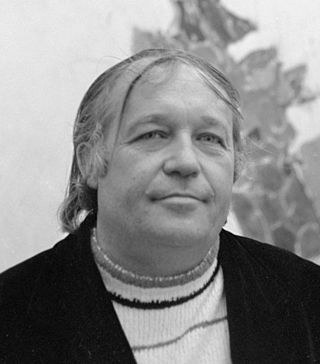
Samuel Lewis Francis was an American painter and printmaker.
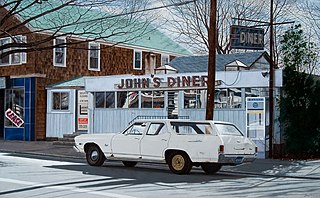
Photorealism is a genre of art that encompasses painting, drawing and other graphic media, in which an artist studies a photograph and then attempts to reproduce the image as realistically as possible in another medium. Although the term can be used broadly to describe artworks in many different media, it is also used to refer specifically to a group of paintings and painters of the American art movement that began in the late 1960s and early 1970s.

Jean-Paul Riopelle, was a Canadian painter and sculptor from Quebec. He had one of the longest and most important international careers of the sixteen signatories of the Refus Global, the 1948 manifesto that announced the Quebecois artistic community's refusal of clericalism and provincialism. He is best known for his abstract painting style, in particular his "mosaic" works of the 1950s when he famously abandoned the paintbrush, using only a palette knife to apply paint to canvas, giving his works a distinctive sculptural quality. He became the first Canadian painter since James Wilson Morrice to attain widespread international recognition.

Jay DeFeo was a visual artist who became celebrated in the 1950s as part of the spirited community of Beat artists, musicians, and poets in San Francisco. Best known for her monumental work The Rose, DeFeo produced courageously experimental works throughout her career, exhibiting what art critic Kenneth Baker called “fearlessness.”

Lawren Stewart Harris LL. D. was a Canadian painter, best known as a leading member of the Group of Seven. He played a key role as a catalyst in Canadian art and as a visionary in Canadian landscape art.

Maria Helena Vieira da Silva was a Portuguese abstract painter. She was considered a leading member of the European abstract expressionism movement known as Art Informel. Her works feature complex interiors and city views using lines that explore space and perspective. She also worked in tapestry and stained glass.

Hans Hofmann was a German-born American painter, renowned as both an artist and teacher. His career spanned two generations and two continents, and is considered to have both preceded and influenced Abstract Expressionism. Born and educated near Munich, he was active in the early twentieth-century European avant-garde and brought a deep understanding and synthesis of Symbolism, Neo-impressionism, Fauvism, and Cubism when he emigrated to the United States in 1932. Hofmann's painting is characterized by its rigorous concern with pictorial structure and unity, spatial illusionism, and use of bold color for expressive means. The influential critic Clement Greenberg considered Hofmann's first New York solo show at Peggy Guggenheim’s Art of This Century in 1944 as a breakthrough in painterly versus geometric abstraction that heralded abstract expressionism. In the decade that followed, Hofmann's recognition grew through numerous exhibitions, notably at the Kootz Gallery, culminating in major retrospectives at the Whitney Museum of American Art (1957) and Museum of Modern Art (1963), which traveled to venues throughout the United States, South America, and Europe. His works are in the permanent collections of major museums around the world, including the Metropolitan Museum of Art, Tate Modern, Germanisches Nationalmuseum, National Gallery of Art, and Art Institute of Chicago.

Joan Mitchell was an American artist who worked primarily in painting and printmaking, and also used pastel and made other works on paper. She was an active participant in the New York School of artists in the 1950s. A native of Chicago, she is associated with the American abstract expressionist movement, even though she lived in France for much of her career.
The Bay Area Figurative Movement was a mid-20th Century art movement made up of a group of artists in the San Francisco Bay Area who abandoned working in the prevailing style of Abstract Expressionism in favor of a return to figuration in painting during the 1950s and onward into the 1960s. Spanning two decades, this art movement is often broken down into three groups, or generations: the First Generation, the Bridge Generation, and the Second Generation.
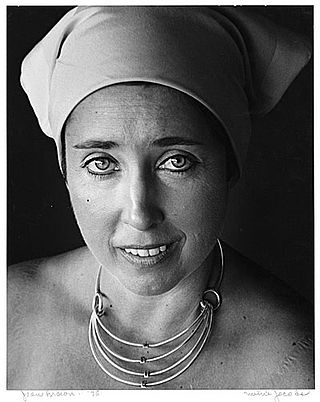
Joan Brown was an American figurative painter who lived and worked in Northern California. She was a member of the "second generation" of the Bay Area Figurative Movement.
Alfred Julio Jensen was an abstract painter. His paintings are often characterized by grids of brightly colored triangles, circles or squares, painted in thick impasto. Conveying a complex web of ideas, often incorporating calligraphy or numerical systems, they are frequently referred to as "concrete" abstract art. After his death in 1981, the Guggenheim organized a major retrospective of his work, having held his solo exhibition there in 1961.
Edward (Ed) Clark was an abstract expressionist painter known for his broad, powerful brushstrokes, radiant colors and large-scale canvases. An African-American, he wasn’t widely recognized as a major modernist until relatively late in a seven-decade career, during which he pioneered the use of shaped canvases and of the everyday push broom to create striking works of art.
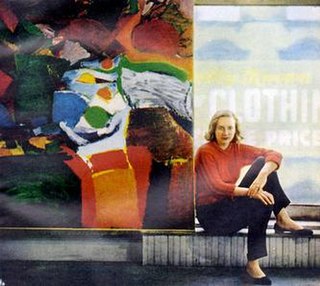
Grace Hartigan was an American Abstract Expressionist painter and a significant member of the vibrant New York School of the 1950s and 1960s. Her circle of friends, who frequently inspired one another in their artistic endeavors, included Jackson Pollock, Larry Rivers, Helen Frankenthaler, Willem and Elaine de Kooning and Frank O'Hara. Her paintings are held by numerous major institutions, including the Museum of Modern Art in New York City. As director of the Maryland Institute College of Art's Hoffberger School of Painting, she influenced numerous young artists.
Joan Balzar was a Canadian artist, known for her vividly coloured hard-edged abstract paintings, which sometimes included metallic powders or neon tubing.
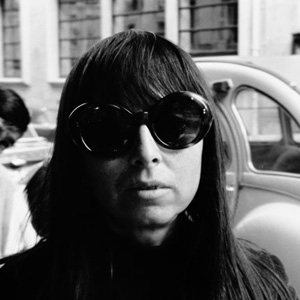
Shirley Goldfarb was an American painter and writer.
Sans Neige is a 1969 oil on canvas triptych painting by the American New York School abstract expressionist artist Joan Mitchell. It is in the permanent collection of the Carnegie Museum of Art in Pittsburgh.
Figure and the City is a seminal 1950 oil on canvas painting by the American visual artist Joan Mitchell.
References
- ↑ "Salut Tom".
- ↑ "Salut Tom".
- ↑ "The Paintings of Joan Mitchell".
- ↑ The Paintings of Joan Mitchell. University of California Press. 2002. ISBN 9780520235700.
- ↑ Joan Mitchell: Lady Painter. Knopf Doubleday Publishing. 3 May 2011. ISBN 9780307595980.
- ↑ "Abstract Expressionism review – a colossal event". TheGuardian.com . 25 September 2016.
- ↑ ""Joan Mitchell": The World Premiere Retrospective at SFMOMA".
- ↑ "Joan Mitchell | Baltimore Museum of Art".
- ↑ "A Large-Scale Joan Mitchell Retrospective to Open in Paris".